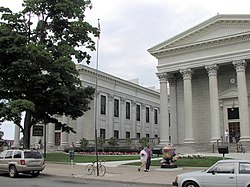Erie, PA Metropolitan Statistical Area
| Erie County, Pennsylvania | |||
|---|---|---|---|

Erie County Courthouse
|
|||
|
|||
 Location in the U.S. state of Pennsylvania |
|||
 Pennsylvania's location in the U.S. |
|||
| Founded | November 7, 1803 | ||
| Named for | Lake Erie | ||
| Seat | Erie | ||
| Largest city | Erie | ||
| Area | |||
| • Total | 1,558 sq mi (4,035 km2) | ||
| • Land | 799 sq mi (2,069 km2) | ||
| • Water | 759 sq mi (1,966 km2), 49% | ||
| Population (est.) | |||
| • (2015) | 278,045 | ||
| • Density | 348/sq mi (134/km²) | ||
| Congressional districts | 3rd, 5th | ||
| Time zone | Eastern: UTC-5/-4 | ||
| Website | www |
||
Erie County is a county located in the U.S. state of Pennsylvania. As of the 2010 census, the population was 280,566. Its county seat is Erie. The county was created in 1800 and later organized in 1803.
Erie County comprises the Erie, PA Metropolitan Statistical Area.
Erie County was established on March 12, 1800 from part of Allegheny County, which absorbed the lands of the disputed Erie Triangle in 1792. Prior to 1792, the region was claimed by both New York and Pennsylvania, so no county demarcations were made until the federal government intervened.
Since Erie County and its newly established neighboring counties of Crawford, Mercer, Venango, and Warren were initially unable to sustain themselves, a five-county administrative organization was established at Crawford County's Meadville to temporarily manage government affairs in the region. Erie elected its own county officials in 1803.
The county was originally settled by immigrants of "Yankee" stock, (immigrants from New England and the western part of New York descended from the English Puritans whose ancestors settled New England in the colonial era). Erie County resembled upstate New York more than it did Pennsylvania with its population primarily consisting of settlers from Connecticut, Rhode Island and Maine. Roads were laid out, post routes established, public buildings erected and people were invited to move there. The original settlers were entirely of New England origins or were Yankees from upstate New York whose families had moved to that place from New England only one generation earlier, in the aftermath of the Revolutionary War. This resulted in Erie County being culturally very contiguous with early New England culture.
...
Wikipedia


